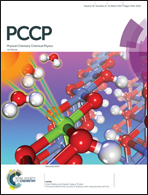An efficient route to fabricate fatigue-free P(VDF-TrFE) capacitors with enhanced piezoelectric and ferroelectric properties and excellent thermal stability for sensing and memory applications†
Abstract
P(VDF-TrFE), the best known ferroelectric polymer, suffers from a rather low piezoelectric response as well as poor electrical fatigue life, hampering its application potential. Herein, we report the fabrication of fatigue free poly(vinylidenedifluoride-trifluoroethylene) P(VDF-TrFE)-based capacitors with record piezoelectric coefficients and excellent thermal stability. We proposed a cost-effective and simple solution-based process to fabricate P(VDF-TrFE)-based memory capacitors with large polarization (8.9 μC cm−2), low voltage operation (15 V), and excellent fatigue endurance with 100% polarization retention up to 108 electrical switching cycles. The thin film capacitors fabricated using methyl ethyl ketone (MEK) and dimethyl sulfoxide (DMSO) as co-solvents also show a much higher piezoelectric coefficient (d33 = −60 pm V−1) than the previously reported capacitors and are also thermally stable up to 380 K, making them ideal candidates for ferro-, piezo-, and pyro-electric applications, even in devices operating above room temperature. The observed results are well supported by first principles calculations, FTIR, XPS, and evaluation of cohesion energy for crystallization by DSC.



 Please wait while we load your content...
Please wait while we load your content...